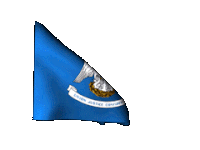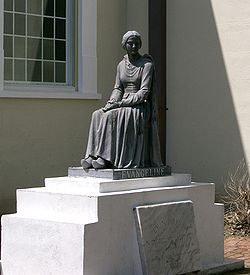Acadians
| Acadian flag Acadian Flag of the Maritimes | |
| Regions with significant populations | |
|---|---|
| Canada: 71,590 (self-identified in 2001 Canadian census) 1 New Brunswick: 26,220 | |
| Languages | |
| Acadian French (a dialect of French) and/or English; some areas speak Chiac; those who have resettled to Quebec typically speak Quebec French. | |
| Religion | |
| Predominantly Roman Catholic | |
| Related ethnic groups | |
| French Québécois |
The Acadians (French: Acadiens) are the descendants of the original French settlers of parts of the northeastern region of North America comprising what is now the Canadian provinces of Nova Scotia, New Brunswick and Prince Edward Island. Although Acadians and Quebecers are both French-Canadian, Acadia was founded four years prior to the founding of Quebec and in a geographically separate area. Consequently, the two cultures are distinct.
In the expulsion of 1755, Acadians were uprooted by the British; many later resettled in Louisiana, where they became known as Cajuns.
History
In 1603 Henry IV, the King of France, granted Pierre Dugua, Sieur de Monts, the right to colonize lands in North America between 40º- 60º North latitude. Arriving in 1604, the French settlers built a fort at the mouth of the St. Croix River which separates present day New Brunswick and Maine, on a small island named Île-Ste-Croix. The following spring, the settlers sailed across the bay to Port-Royal (Annapolis Royal) in present day Nova Scotia.
During the 17th century, about one hundred French families were established in Acadia. They developed friendly relations with the aboriginal Mi'kmaq, learning their hunting and fishing techniques. The Acadians lived mainly in the coastal regions, farming land reclaimed from the sea through diking. Lying on the frontier between French and British territories, the Acadians found themselves on the frontlines in each conflict between the powers. Acadia was passed from one side to the other repeatedly, and the Acadians learned to survive through an attitude of studied neutrality, refusing to take up arms for either side, and thus they came to be referred to as the "French neutrals."
In the Treaty of Utrecht in 1713, France ceded that portion of Acadia which is now Nova Scotia (minus Cape Breton Island) to the the British for the last time. The British government considered for decades what to do with the resident French population. In the 1750s, Britain began to consider possible deportation, while, at the same time, building up the Protestant population, particularly in the Halifax area When the French and Indian War began in 1754, the British government, no longer accepting the neutrality previously granted to the Acadians, demanded that they take an absolute oath of allegiance to the British monarch, which would require taking up arms. The Acadians did not want to take up arms against family members who were in French territory, and believed that the oath would compromise their Roman Catholic faith, and refused. Colonel Charles Lawrence ordered the mass ethnic cleansing of the Acadians, without authority from London and despite earlier cautions from British authorities against drastic action.

In what is known as the Great Expulsion (Grand Dérangement), more than 12,000 Acadians (three-fourths of the Acadian population in Nova Scotia) were expelled, their homes burned and their lands confiscated. Families were split up, and the Acadians were dispersed throughout the British lands in North America; some were returned to France.
In 2003, at the request of Acadian representatives, notably Erath, Louisiana, attorney Warren A. Perrin, a proclamation was issued in the name of Queen Elizabeth II, acting as the Canadian monarch, officially acknowledging the deportation and establishing July 28 as a day of commemoration. The day of commemoration is observed by the Government of Canada, as the successor of the British Government.
Geography
The Acadians today inhabit predominantly the northern and eastern shores of New Brunswick. Other groups of Acadians can be found in the Magdalen Islands and throughout other parts of Quebec, in Prince Edward Island and Nova Scotia such as Chéticamp and Clare. Still others can be found in the southern and western regions of New Brunswick and in New England. Many of these latter communities have faced varying degrees of assimiliation. For many families in predominantly anglophone communities, French language attrition has occurred, particularly in younger generations. The Acadians who settled in Louisiana after 1764, known as Cajuns, have had a dominant cultural influence in many parishes, particularly in the southerwestern area of Louisiana known as Acadiana.
Culture
Today Acadians are a vibrant minority, particularly in New Brunswick and Louisiana (Cajuns).
Notable Acadians in the Maritimes include singers Angèle Arsenault and Edith Butler, writer Antonine Maillet, boxer Yvon Durelle, pitcher Rheal Cormier, former Governor General Roméo LeBlanc, former premier of Prince Edward Island Aubin-Edmond Arsenault, the first Acadian premier of any province and the first Acadian appointed to a provincial supreme court, his father, Joseph-Octave Arsenault, the first Acadian appointed to the Canadian Senate, and former New Brunswick premier Louis Robichaud, who was responsible for modernizing education and the government of New Brunswick in the mid-20th century.
August 15, the feast of the Assumption, is the national feast day of the Acadians. The national anthem of the Acadians is "Ave, maris stella". On that day, the Acadians celebrate by having the tintamarre which consists mainly of a big parade where people can dress up with the colours of Acadia and make a lot of noise. The flag of the Acadians is the French tricolour with a golden star in the blue field, which symbolizes the Blessed Virgin Mary, the "Star of the Sea". This flag was adopted in 1884 at the Acadian National Congress in Miscouche, PEI.
Acadians in the diaspora have adopted other symbols. The flag of Acadians in Louisiana was designed by Thomas J. Arceneaux of the University of Louisiana at Lafayette, and adopted by the Louisiana legislature as the official emblem of the Acadiana region in 1974. A group of New England Acadians attending Le Congrès Mondial Acadien in Nova Scotia in 2004, endorsed a design for a New England Acadian flag by William Cork, and are advocating for its wider acceptance.

Flag of Acadiana Region of Louisiana
New England Acadian flag
Flag of New England Acadians
Since 1994, the Congrès Mondial Acadien has united Acadians of the Maritimes, New England, and Louisiana. The first was in Shediac, New Brunswick in 1994, the second in Lafayette, Louisiana, in 1999. The third, held in Nova Scotia in 2004, celebrated the 400th anniversary of the arrival of the first French-speaking settlers in Canada. As in the previous gatherings, musical festivals and theatrical productions displayed Acadian culture, and academics debated the meaning of Acadia in the 21st century. Debates included the best ways of preserving Acadian culture in an overwhelmingly English area, and what exactly an Acadian is in 2004. Some Acadians in the Maritimes do not recognize more recent immigrants as true Acadians, although most people accept any French-speaking Maritimer as an Acadian. There is also an argument about whether the decendants of Acadians, who do not speak French, qualify.
Language
Acadians speak a dialect of French called Acadian French. Many of those in the Moncton area speak Chiac and English.
Legend
The American folklore hero, Paul Bunyan, is believed by some to have been influenced if not inspired by Acadian stories about lumberjacks.
The Expulsion in literature

. In 1847, an epic poem by American writer Henry Wadsworth Longfellow, Evangeline, was loosely based on the events surrounding the 1755 deportation. The poem became an American classic, and also contributed to a rebirth of Acadian identity in both Maritime Canada and in Louisiana.
Robbie Robertson wrote a popular song based on the Acadian Expulsion titled "Acadian Driftwood" that appeared on The Band's 1975 album, Northern Lights — Southern Cross.
Antonine Maillet's Pélagie-la-charette concerns the return voyage to Acadia of several deported families starting 15 years after the Great Expulsion.
See also
External links
- Lucie LeBlanc Consentino's Acadian Home website is a respected and frequently cited source of information on Acadian history and genealogy, with particular emphasis on primary sources and on Acadians in New England.
- L'Acadie Toujours! is another webpage focusing on Acadians in New England.
- Acadian-English Dictionary from Webster's Online Dictionary - the Rosetta Edition
References
Dupont, Jean-Claude (1977). Héritage d'Acadie. Montreal: Éditions Leméac.
Faragher, John Mack (2005). A Great and Noble Scheme: The Tragic Story of the Expulsion of the French Acadians from their American Homeland. New York: W. W. Norton & Company.
Frink, Tim (1999). New Brunswick, A Short History. Summerville, N.B.: Stonington Books.
Notes
1 Canadian census, ethnic data. Rather than go by self-identification, many would instead define an Acadian as a French speaking person living in the Maritime provinces of Canada; which according to the same 2001 census, was 276,355 (236,665 in New Brunswick, 34,025 in Nova Scotia, and 5,665 in PEI).[1]
2
Le Grand Dérangement An exhibit done by the Massachusetts State Archives in conjunction with the Commonwealth Museum. This was made possible through a grant from the National Endowment for the Humanities. For more in-depth information of the role of Massachusetts in Le Grand Dérangement contact or visit the Massachusetts State Archives at: http://www.sec.state.ma.us/arc/arcidx.htm
